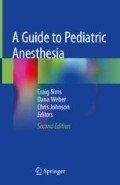Abstract
Regional anesthesia in children differs in many respects from adults. Most pediatric regional blocks are placed after induction of anesthesia to provide post-operative analgesia. Complications associated with this approach are very low as shown by several large prospective surveys. Local anesthetic spread is generally more reliable than in adults, but higher volumes in relation to body weight are usually required for neuraxial single shot blocks and infusions. Single shot blocks and wound infiltration are commonly used to minimize opiate use in day case surgery and to reduce the distress frequently seen when small children emerge from anesthesia with inadequate analgesia. The pharmacokinetics of local anesthetic agents are different in neonates and young children compared with adults. There is a high risk of toxicity in neonates and infants because of reduced protein binding and metabolism. Local anesthetic additives are not as well studied and less frequently used in children compared with adults. Clonidine however, is frequently added during caudal block to prolong duration and provide sedation. Sedation is sometimes an important addition to regional techniques, because good analgesia alone does not guarantee lack of distress, particularly in pre-school children who may be distressed by their environment, restriction of movement or effects of surgery or equipment.
Access this chapter
Tax calculation will be finalised at checkout
Purchases are for personal use only
Further Reading
Davidson A, et al. Apnea after awake regional and general anesthesia in infants. The general anesthesia compared to spinal anesthesia study—comparing apnea and neurodevelopmental outcomes, a RCT. Anesthesiology. 2015;123:38–54.
Frawley G, Ingelmo P. Spinal anaesthesia in the neonate. Best Pract Res Clin Anaesthesiol. 2010;24:337–51. A detailed description of anatomy and technique of spinal anesthesia from the Royal Children’s Hospital in Melbourne.
Ingelmo P, et al. The optimum initial pediatric epidural bolus: a comparison of four local anesthetic solutions. Pediatr Anesth. 2007;17:1166–75.
Ivani G, Mossetti V. Continuous central and perineural infusions for postoperative pain control in children. Curr Opin Anesthesiol. 2010;23:637–42.
Johr M. Regional anesthesia in neonates, infants and children. An educational review. Eur J Anesthesiol. 2015;32:1–9.
Wiegele M et al. Caudal epidural blocks in paediatric patients. BJA. 2019;122:509–17.
Lees D, et al. A review of the surface and internal anatomy of the caudal canal in children. Pediatr Anesth. 2014;24:799–805.
Llewellyn N, Moriarty A. The national pediatric epidural audit. Pediatr Anesth. 2007;17:520–33.
Lonnqvist PA. Adjuncts should always be used in pediatric regional anesthesia. Pediatr Anesth. 2015;25:100–6.
Lundbald M, Lonnqvist P. Adjunct analgesic drugs to local anesthetics for neuraxial blocks in children. Curr Opin Anesthesiol. 2016;29:626–31.
Marhofer P. Regional blocks carried out during general anesthesia: myths and facts. Curr Opin Anesthesiol. 2017;30:621–6. A review article showing in adults and children, blocks performed under anesthesia are as safe or safer than awake.
Mossetti B, Ivani G. Controversial issues in pediatric regional anesthesia. Pediatr Anesth. 2012;22:109–14. Discussion of test doses.
Rochette A, et al. Cerebrospinal fluid volume in neonates undergoing spinal anaesthesia: a descriptive magnetic resonance imaging study. Br J Anaesth. 2016;117:214–9.
Sandeman DJ, et al. Ultrasound guided dorsal penile nerve block in children. Anesth Intens Care. 2007;35:266–9.
Suresh S, Sawardekar A, Shah R. Ultrasound for regional anesthesia in children. Anesthesiol Clin. 2014;32:263–9.
Teunkens A, Van de Velde M, et al. Dorsal penile nerve block for circumcision in pediatric patients: a prospective, observer-blinded, randomized controlled clinical trial for the comparison of ultrasound-guided vs landmark technique. Pediatr Anesth. 2018;28:703–9.
Tsui BCH, Suresh S. Ultrasound Imaging for regional anesthesia in infants, children and adolescents. Anesthesiology. 2010;112:473–92 and 719–28.
Walker BJ, et al. Complications in pediatric regional anesthesia; an analysis of more than 100,000 blocks from the pediatric regional anesthesia network. Anesthesiology. 2018;129:721–32. A large prospective study from the multicenter PRAN group.
Visoiu M. Paediatric regional anaesthesia: a current perspective. Curr Opin Anesthesiol. 2015;28:577–82.
Willschke H, et al. Current trends in paediatric regional anaesthesia. Anaesthesia. 2010;65(Suppl 1):97–104.
Zywicke HA, Rozzelle CJ. Sacral dimples. Pediatr Rev. 2011;32:109–13.
Author information
Authors and Affiliations
Editor information
Editors and Affiliations
Review Questions
Review Questions
-
1.
Describe anatomy and technique to perform caudal epidural block for postoperative pain relief for circumcision in a 3 year old. What volume and concentration of agents will be required?
Why isn’t a fluid load required before performing the block?
-
2.
What factors need to be considered when running local anesthetic infusions in neonates?
-
3.
What are the local anesthetic options to provide pain relief after bilateral inguinal hernia repair in a 2 year old? What are the risks and benefits of each technique?
-
4.
You are about to perform a caudal block for a 8 month old baby and you notice a midline indentation in the skin in the sacral region. How will you decide if it is still safe to proceed with the caudal?
-
5.
You plan to perform a spinal block in 3 month old baby. What level will you insert the needle? What local anesthetic will you use, and how much will you inject? How long is this block likely to last? If the baby becomes apneic, what might this indicate?
Rights and permissions
Copyright information
© 2020 Springer Nature Switzerland AG
About this chapter
Cite this chapter
Johnson, C., Gibson, C. (2020). Regional Anesthesia for Infants and Children. In: Sims, C., Weber, D., Johnson, C. (eds) A Guide to Pediatric Anesthesia. Springer, Cham. https://doi.org/10.1007/978-3-030-19246-4_10
Download citation
DOI: https://doi.org/10.1007/978-3-030-19246-4_10
Published:
Publisher Name: Springer, Cham
Print ISBN: 978-3-030-19245-7
Online ISBN: 978-3-030-19246-4
eBook Packages: MedicineMedicine (R0)

